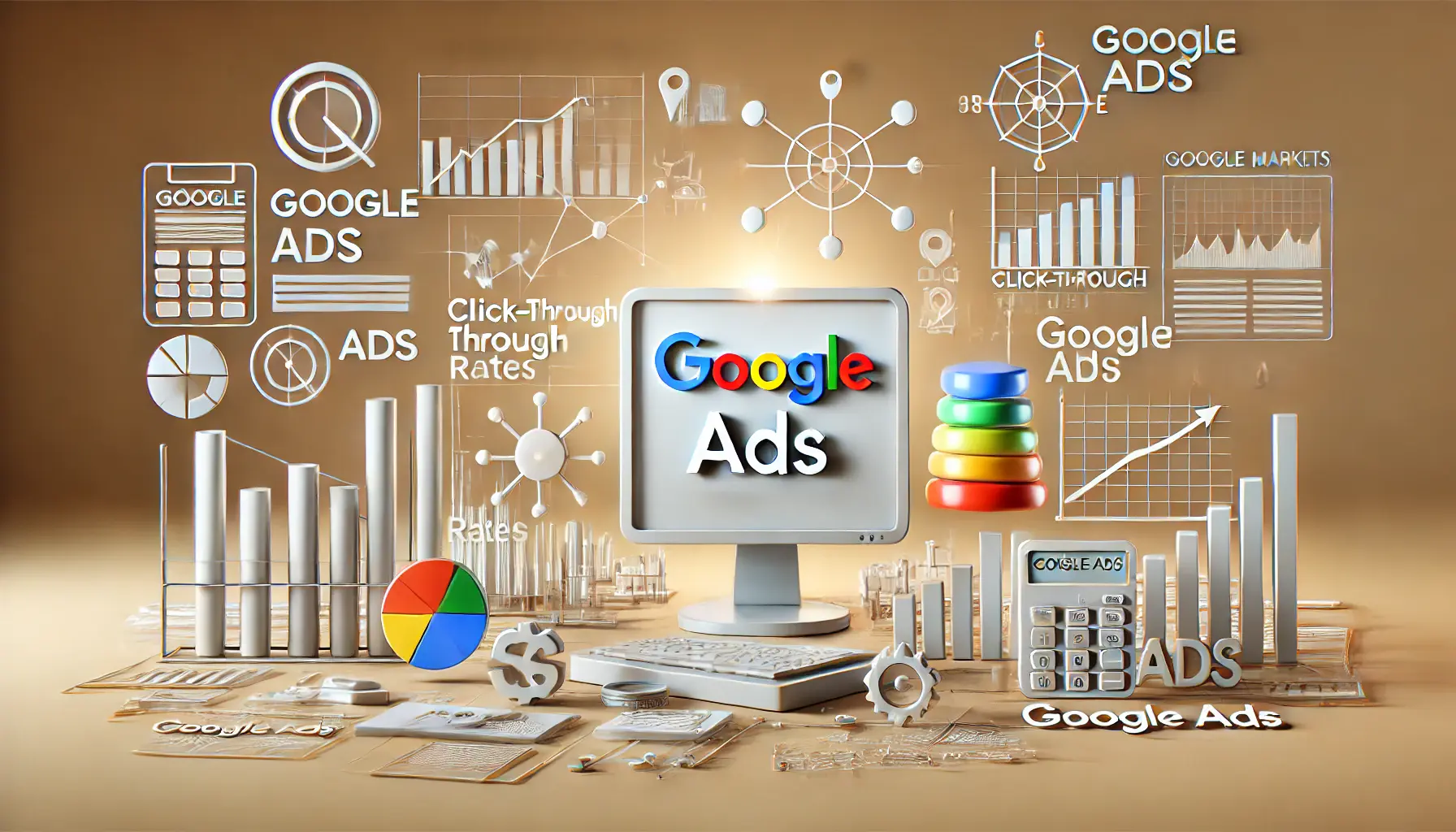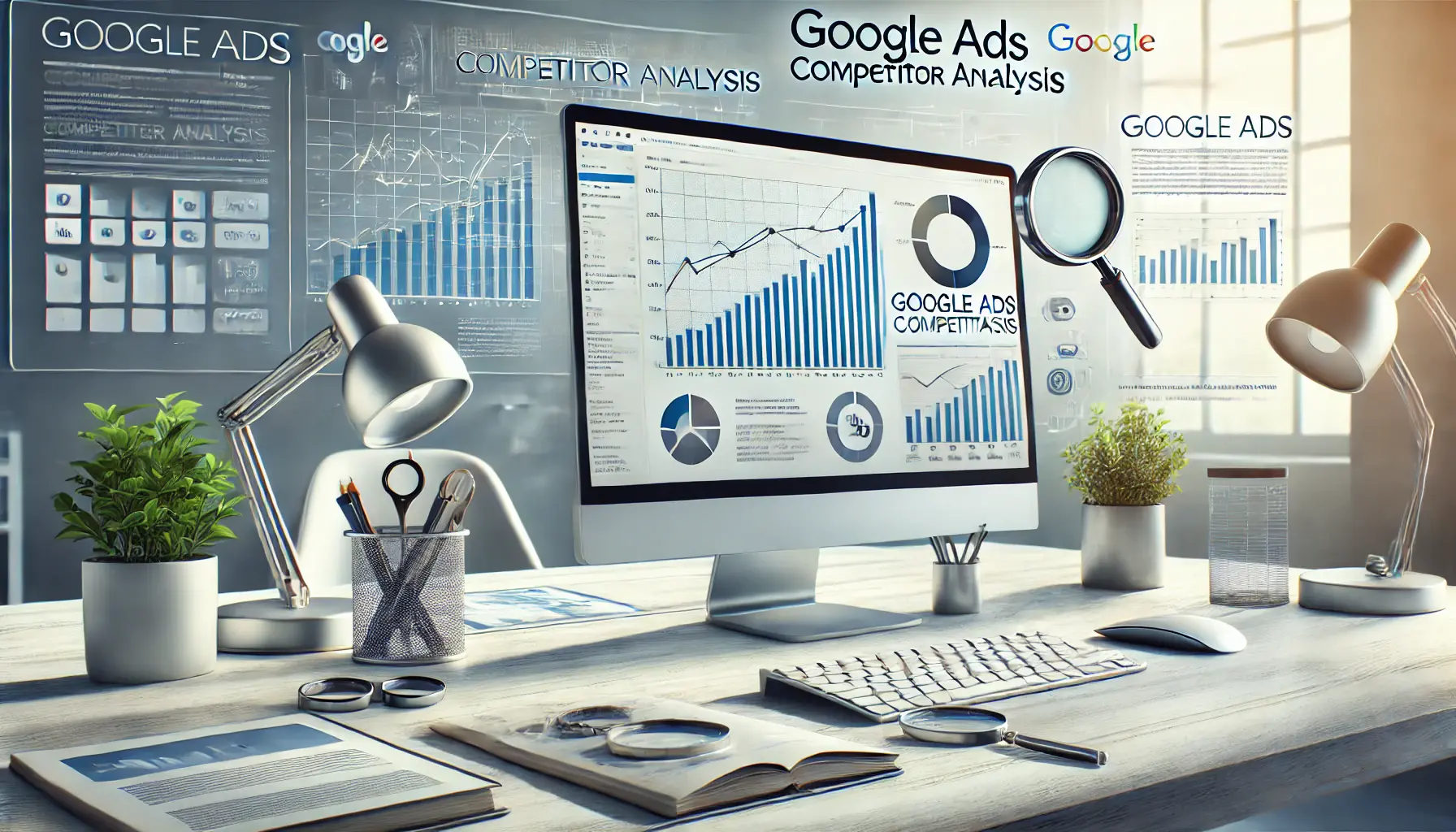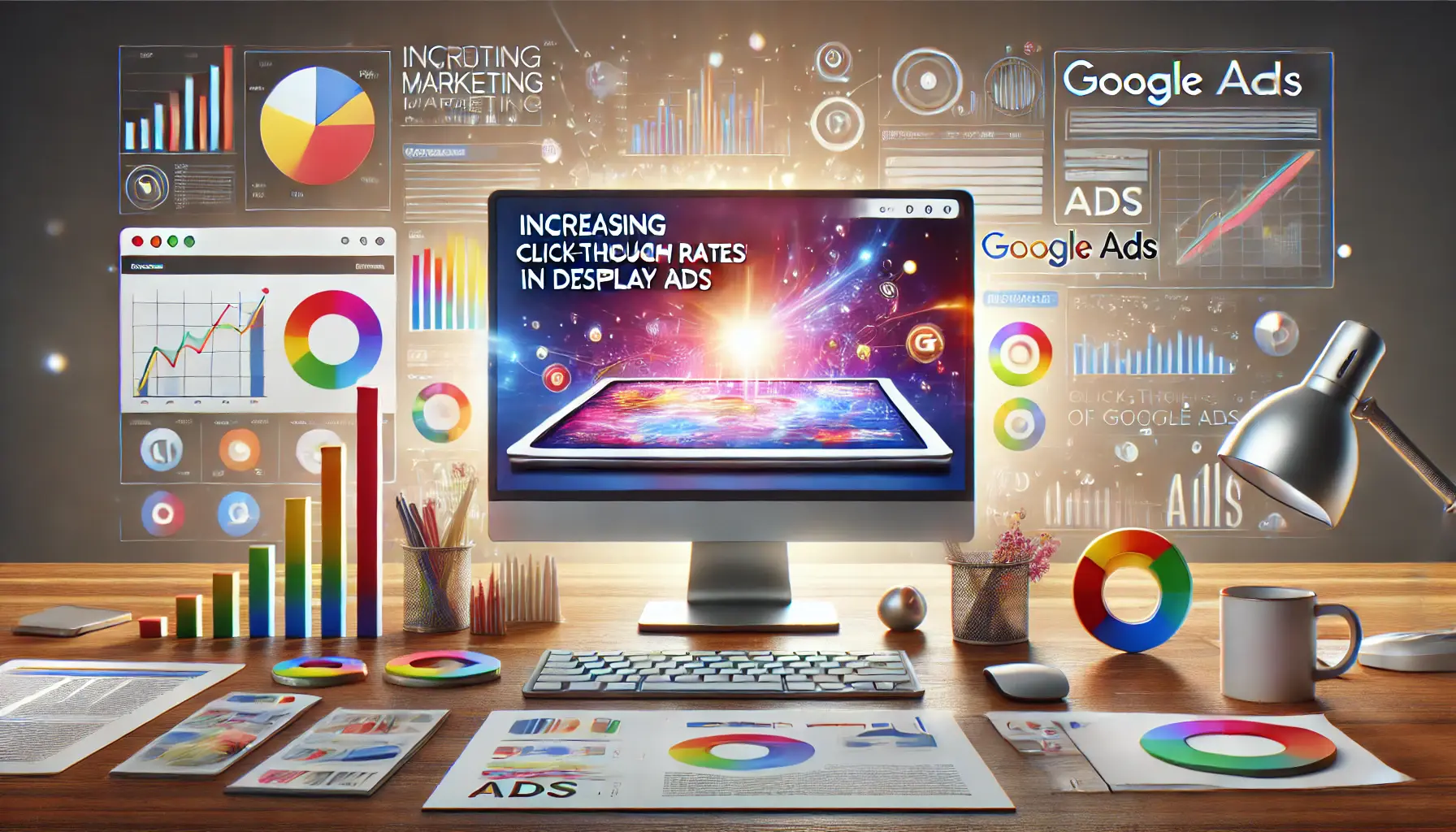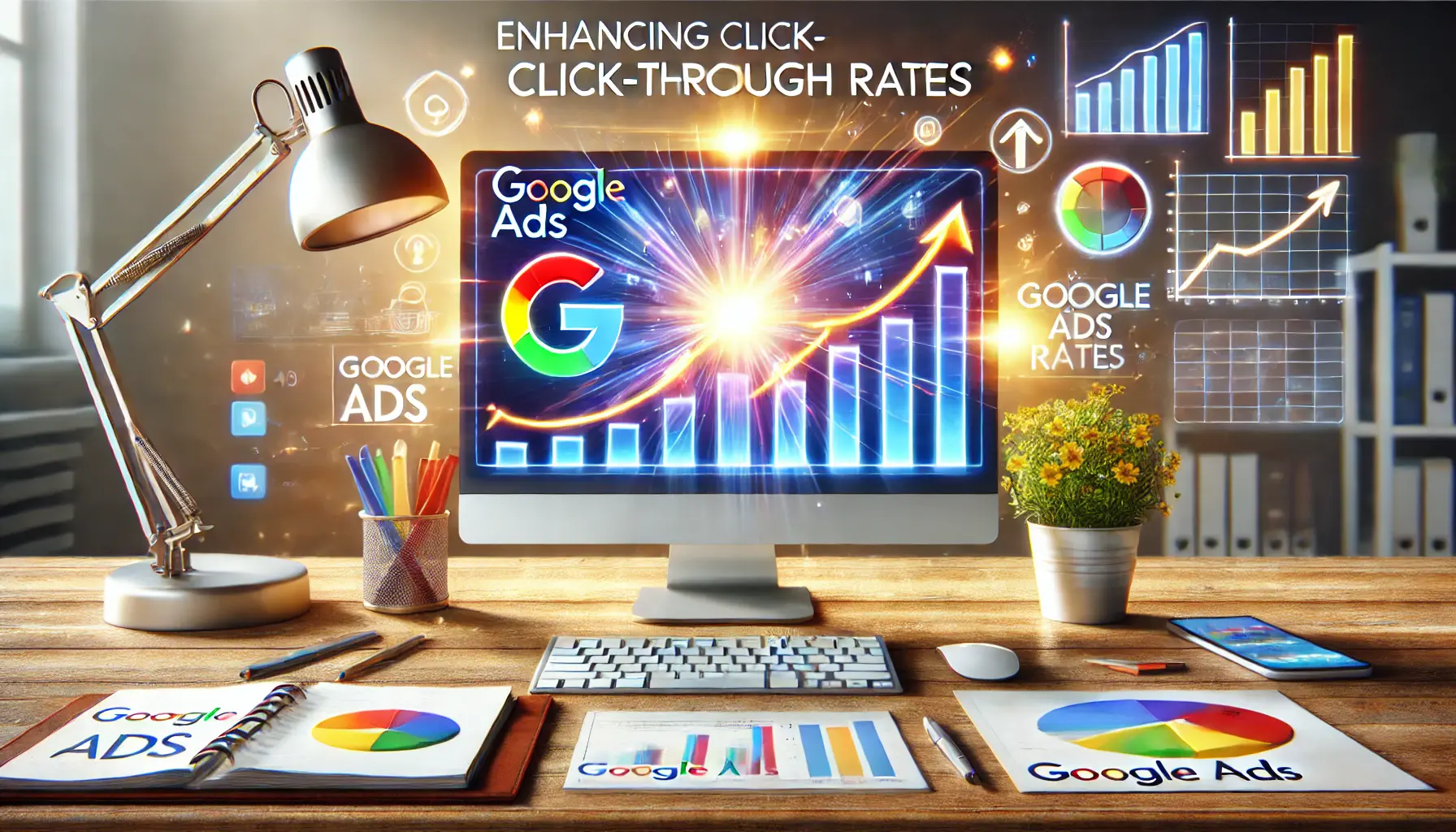The following is in regard to clicking on your ads in this competitive world of digital advertising.
In the case of Google Ads, click-through rate improvement (CTRClick-Through Rate, the percentage of people who click an ad after seeing it. improvement) can make or break the success of an ad campaign.
But what exactly is CTR, and why should you focus on it?
Quite simply, it’s the percentage of people who click through to your ad after they viewed it.
A higher CTR means your ad more accurately resounds with viewers, and it’s also useful in developing your ad’s Quality ScoreA metric used by Google to assess the relevance and quality of an ad, affecting ad position and cost. that can result in lower costs per click with improved ad positions.
In this article, you will learn all the effective strategies and best ways to enhance CTR in Google Ads for better precision in reaching out to your target audience.
- Understanding Click-Through Rate (CTR) in Google Ads
- Effective Strategies for Improving CTR in Google Ads
- Optimizing Creative and Ad Formats to Increase CTR
- Audience Targeting for Higher CTR: How to Nail It?
- Analyzing and Monitoring CTR for Continuous Improvement
- How to Always Improve Click-Through Rate in Google Ads
- Frequently Asked Questions About CTR Improvement in Google Ads
Understanding Click-Through Rate (CTR) in Google Ads
Click-through rate improvement, or CTR, is a simple but key metric in Google Ads that calculates how many times people have clicked through on your ad after having seen it.
It is a clear gauge of how well an ad is captivating targeted viewers by relating to them.
However, there is much more to it than just the numbers – a high CTR signifies well-written ad copy, effective keyword targeting, and profound insight into one’s audience.
If you’re trying to enhance your ad performance, the first thing you need to do is grasp what CTR is.

A visual representation of Click-Through Rate (CTR) and its importance in ad performance.
What is CTR and Why It Matters
CTR, or click-through rate, is calculated by taking the number of clicks and dividing by the number of impressions – how many times your ad was shown – and then multiplying by 100 to give you a percentage.
For example, if your ad shows up 100 times and is clicked on 5 times, then your CTR is 5%.
But why is this number so important?
First, CTR directly influences your ad’s Quality Score – a gating factor responsible for determining ad positioning and cost-per-click (CPCCost-Per-Click, a model where advertisers pay each time a user clicks on their ad.).
The better your CTR, the more relevant your ad will be perceived by Google, which should reduce your CPC while increasing your ad positioning.
Second, a good CTR is also indicative of your ad message matching the intent of your targeted audience, which, in turn, leads to higher engagement and better ROIReturn on Investment, a measure of the profitability of an ad campaign..
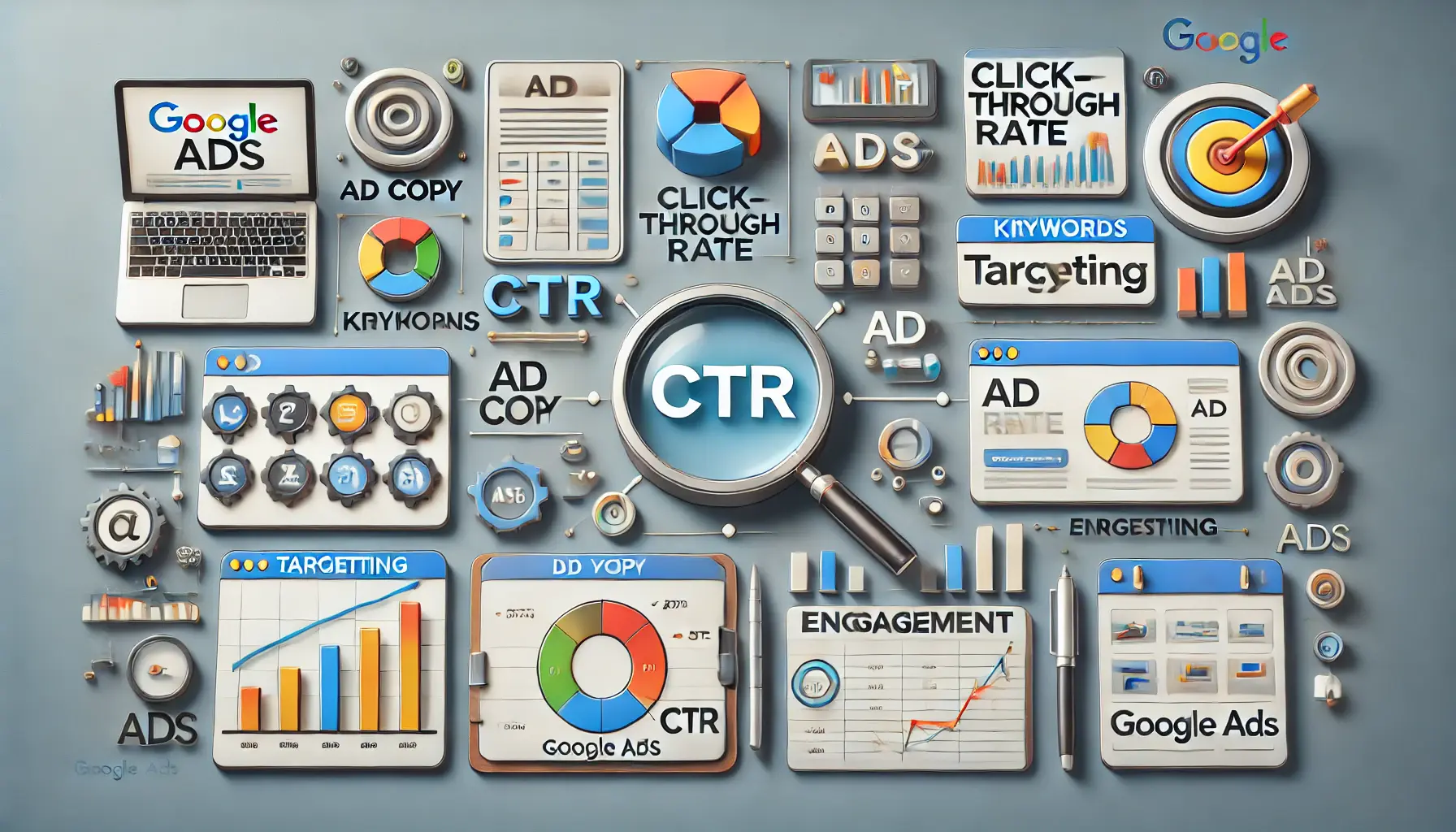
Illustration of key factors impacting CTR in Google Ads campaigns.
Factors Influencing CTR in Google Ads
Various factors influence your click-through rate improvement.
Knowing what these are will allow you to make the changes that are needed for its betterment:
- Ad Copy: You will need to create a captivating ad copy that catches the eye and exactly speaks to the intention of users. Make it talk about pain points or offer high-value benefits.
- Keywords: Using relevant keywords within your ad copy and targeting helps Google align your ad with the right audience. Targeting high-intent keywords often leads to higher CTRs.
- Ad Extensions: Adding sitelinks, callouts, or even structured snippets exposes more about your ad and provides additional value, encouraging more clicks.
- Relevance and Intent: Closely aligning your ad message with what users are searching for increases relevance and leads to better engagement.
These factors can really determine how often users click on your ad.
Even small changes can make a real difference in CTR.

Representation of CTR benchmarks across different industries in Google Ads.
Average CTR Benchmarks by Industry
CTR benchmarks depend on the industry, and it is helpful to know what the average CTR in your particular industry might be.
For example, e-commerce or travel may have different CTR averages compared to healthcare or finance.
Here are some rough industry benchmarks to give you an idea:
- E-commerce: 2.69%
- Travel and Hospitality: 4.68%
- Finance: 2.65%
- Healthcare: 3.27%
Understanding these benchmarks can help you set realistic goals and measure the success of your click-through rate improvement efforts.

Illustration of CTR’s role in enhancing ad performance and Quality Score in digital advertising.
How CTR Impacts Ad Performance and Quality Score
CTR is more than just a performance metric; it’s a crucial determinant of your ad’s Quality Score within Google Ads.
Quality Score is Google’s measure of relevance and quality in your ad.
Ads with high Quality Scores tend to rank higher, cost less per click, and drive better results overall.
By improving your CTR, you’re working on boosting your engagement rate while also setting yourself up for better ad placements and lower costs.
Understanding CTR in depth and optimizing it in Google Ads will help you achieve better ad performance, higher ad visibility, and improved ROI.
In the succeeding sections, we’ll go through proven strategies and techniques to take your CTR to the next level.
CTR is a fundamental metric indicating ad effectiveness, linking viewer interest to ad relevance and Quality Score.

Illustration of strategies to improve CTR in Google Ads through targeted tactics.
Effective Strategies for Improving CTR in Google Ads
Improving CTR is essential to drive deeper engagement and conversions in Google Ads.
An optimized CTR ensures your ads are noticed by your targeted audience, which can lead to better Quality Scores, potentially resulting in improved ad placements and reduced costs.
In this section, we’ll discuss some effective ways to increase CTR in Google Ads, covering areas like ad copy, keyword targeting, and ad extensionsAdditional information added to an ad, such as sitelinks or callouts, to improve visibility and engagement..

Illustration of the creative elements involved in writing appealing ad copy.
Writing Appealing Ad Copy
Crafting ad copy that truly resonates with your audience is one of the strongest ways to enhance CTR.
Here are a few tips on creating effective ad copy:
- Mention Unique Selling Points: Highlight what makes your product or service different from others. Emphasize unique features or benefits to capture the attention of your target audience.
- Use Action-Oriented Language: Phrasing like “Discover Now,” “Learn More,” or “Get Started” encourages users to click. Action-oriented language makes your ad more appealing and organically improves CTR over time.
- Incorporate Keywords Naturally: Adding keywords to your ad copy helps with relevance and visibility in search results. Ensure that keywords are naturally integrated to keep the ad readable and impactful.
- Address User Pain Points: Identify common problems or needs of your audience and show how your offering can solve them. This helps create an emotional connection that encourages clicks.

Illustration of how relevant keyword usage boosts CTR in digital ads.
Relevant Keyword Usage for Better CTR
Keyword targeting is critical to ensure your ads appear in the most relevant searches.
Here’s how you can use keywords effectively to improve CTR:
- Target High-Intent Keywords: Use keywords that reflect high purchase intent, like “buy,” “best,” or “affordable,” to attract qualified traffic and improve CTR.
- Use Long-Tail Keywords: Long-tail keywords are more specific and usually face less competition. They help attract a targeted audience, which often leads to a higher CTR.
- Optimize for Negative Keywords: Exclude irrelevant keywords that may attract the wrong audience. Adding negative keywords ensures your ads don’t appear for irrelevant queries, improving CTR for relevant searches.
- Select Appropriate Match Types: Use match types like phrase match or exact match for more targeted results. Broad match can sometimes lead to impressions from irrelevant searches, which can reduce CTR.

Illustration of ad extensions used to boost visibility in digital advertising.
Using Ad Extensions to Gain More Visibility
Ad extensions are additional pieces of information that make your ad more informative and appealing.
Using ad extensions can increase CTR by offering more clickable options:
- Sitelink Extensions: Add links to specific pages on your website, like “About Us” or “Contact,” allowing users to explore and engage with your brand further.
- Callout Extensions: Brief, impactful phrases like “Free Shipping” or “24/7 Support” showcase your brand’s benefits and entice clicks.
- Structured Snippets: Highlight categories or services, such as “Popular Services,” to provide more information without taking up additional space in your ad.
- Location Extensions: If relevant, add your business location to attract local customers, which can effectively improve CTR among local searchers.

Illustration of techniques to boost ad relevance for higher targeted CTR.
Improving Ad Relevance for Targeted CTR
Ensuring ad relevance is crucial for attracting the right audience.
The closer your ad is to user intent, the higher your CTR.
Here’s how to increase ad relevance:
- Align Ad Copy with Keywords: Make sure your ad copy matches the keywords you’re targeting to maintain relevance and engagement.
- Create Targeted Ads for Each Ad Group: Avoid generic ad copy. Tailor ads to specific ad groups for better alignment with user intent and higher CTR.
- Use Dynamic Keyword Insertion (DKI): DKI automatically updates your ad copy to include the exact term a user entered, increasing relevance and encouraging clicks.
By implementing these strategies, you’ll be well on your way to achieving a noticeable boost in CTR for your Google Ads.
Each tactic contributes to enhanced engagement, making your ads more appealing and relevant to potential customers.
Implementing targeted strategies, from ad copy to ad extensions, can significantly enhance CTR and ad performance.
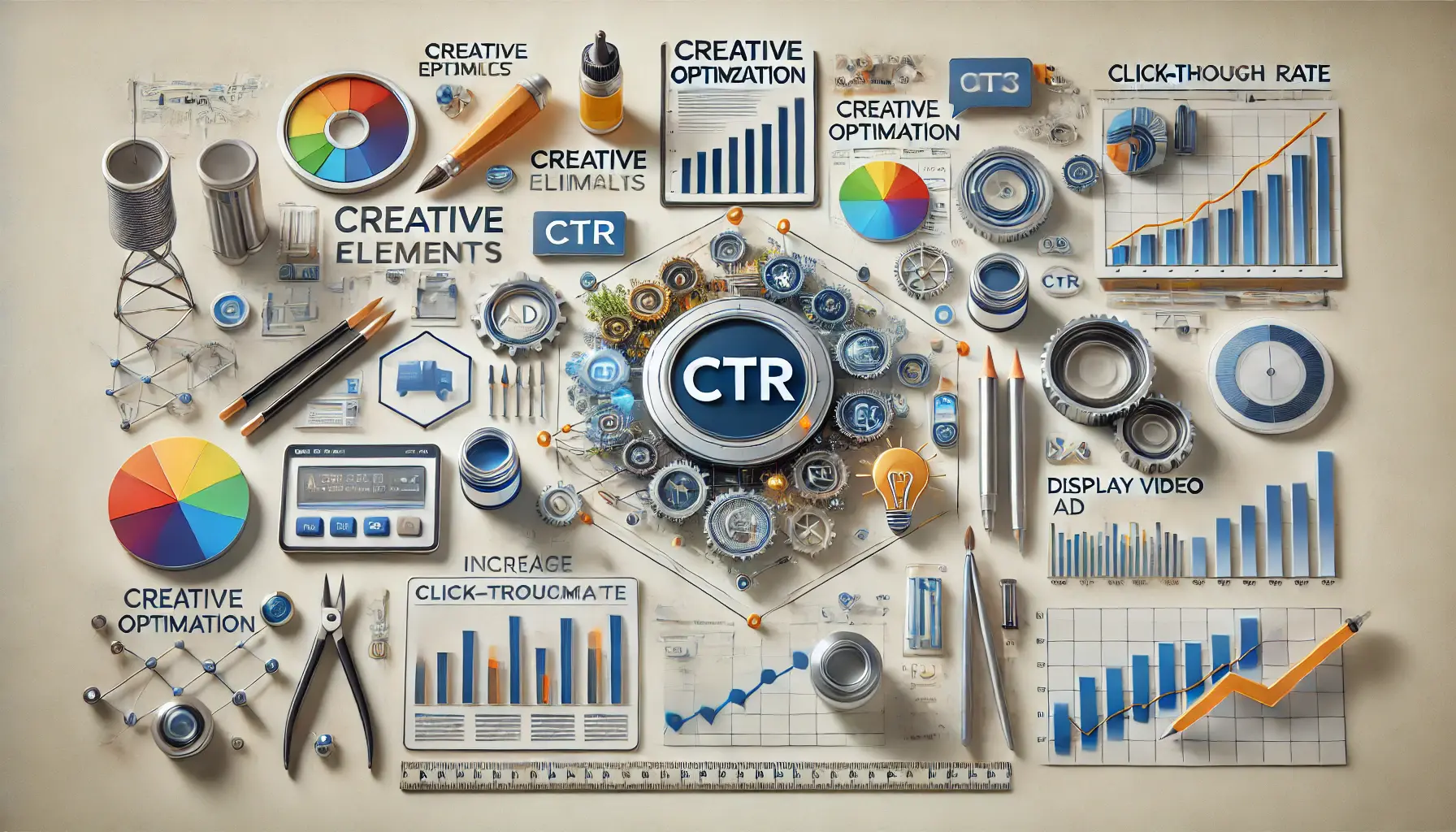
Illustration of creative and format optimization strategies to enhance CTR.
Optimizing Creative and Ad Formats to Increase CTR
Attention is easily captured through compelling visuals.
Optimizing your ad formats and visuals in Google Ads can make your ads stand out, helping to boost click-through rate improvement and overall ad performance.
Whether you’re using text ads, display ads, or responsive formats, finding the right visuals and optimizing formats can improve engagement and relevance for your audience.
Here are some tips to help improve your CTR through effective visual elements and ad formats:

Illustration of the selection process for optimal ad formats in digital advertising.
Choosing the Right Ad Format
Google Ads provides various ad formats, each with its unique strengths.
Choosing the right format based on your goals and target audience can make a significant difference in CTR:
- Responsive Display Ads: These ads automatically adjust in size, appearance, and format to fit available ad spaces. They are flexible and can maximize visibility across the Google Display Network, increasing the chances of reaching a wider audience.
- Video Ads: Video content is highly engaging and can be used to tell a story, demonstrate your product, or share customer testimonials. Well-crafted video ads often result in higher CTRs, especially on platforms like YouTube.
- Shopping Ads: For e-commerce, Shopping ads show product images, prices, and reviews directly in the ad. These features resonate well with users who have high purchase intent, driving strong CTR improvement.

Illustration of strategies for enhancing ads with eye-catching visual elements.
Incorporating Eye-Catching Visual Elements
Well-designed visuals are essential for attracting user interest.
Here’s how to incorporate eye-catching elements into your ads:
- High-Quality Images: Avoid low-resolution images. High-quality visuals create a positive impression and make your ad look professional, attracting more clicks.
- Include Clear Call-to-Action: Adding a prominent CTA button like “Shop Now” or “Sign Up Today” within your visual ad can encourage immediate action.
- Branding Consistency: Use consistent brand colors, logos, and fonts throughout your visuals to build brand recognition and trust, which can lead to increased CTR.

Illustration of A/B testing methods for visuals and ad formats in digital advertising.
Running A/B Testing of Visuals and Formats
A/B testing is an effective way to determine what resonates most with your target audience in terms of visuals and format.
Testing different versions helps identify the best-performing elements:
- Test Variations of Images, Headlines, and Descriptions: Experiment with different combinations of images, headlines, and descriptions to find what works best with your audience.
- Experiment with CTA Placement: Adjust the position and size of CTA buttons to see how they affect engagement. Small changes can often lead to noticeable improvements in CTR.
- Monitor and Refine: Continuously observe your test results and make adjustments based on performance data. Regular refinement of visuals and formats helps maintain CTR growth.

Illustration of strategies to optimize responsive display ads across devices.
Best Practices for Responsive Display Ads
Responsive display ads are highly adaptable and can help improve CTR by maximizing ad placements.
Here’s how to make the most of responsive display ads:
- Upload Multiple Images and Logos: Google Ads allows multiple images and logos, which are automatically optimized for various placements. This flexibility can increase relevance and engagement across different devices.
- Refresh Visuals Regularly: Update your images and content periodically to prevent ad fatigue. Refreshing visuals keeps your audience interested and helps sustain CTR performance.
These strategies are powerful ways to maximize your CTR with the right ad visuals and formats.
By selecting the right formats, using striking visuals, and consistently testing and refining, you’ll be on your way to capturing attention, driving clicks, and achieving better outcomes with Google Ads.
Using visually appealing and well-optimized ad formats captures audience attention, driving higher CTR and engagement.

Illustration of strategies for effective audience targeting to improve CTR.
Audience Targeting for Higher CTR: How to Nail It?
The best way to increase your click-through rate improvement in Google Ads is to ensure you are targeting the right audience.
Accurate audience targeting helps display your ads to users most likely to engage, resulting in increased CTR and conversion rates.
Google Ads offers a range of targeting options, from demographics to interests and remarketing, allowing for highly targeted campaigns.
Here is a breakdown of effective audience targeting techniques that can help improve your ad’s CTR.
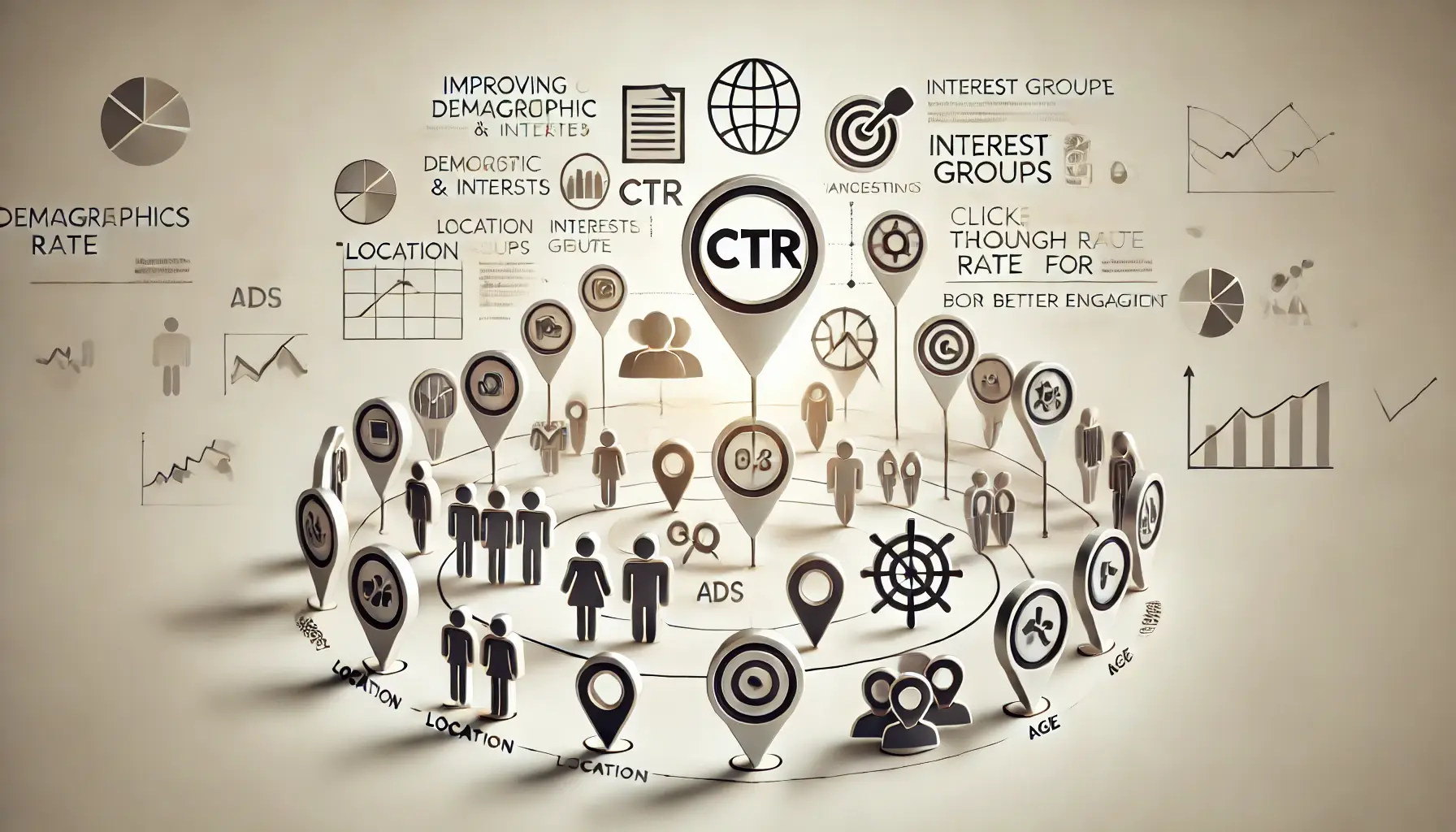
Illustration of demographic and interest-based targeting for improved CTR.
Using Demographics and Interests for Better CTR
Targeting based on demographic and interest allows you to reach groups of people with specific characteristics, such as age, gender, and interests.
Here’s how this strategy can help in improving your CTR:
- Demographic Targeting: Target key demographic details like age, gender, and parental status. This ensures your ad reaches the most relevant audience. For example, if your product targets a younger demographic, it’s beneficial to focus on younger age groups to enhance engagement and CTR.
- Interest-Based Targeting: Use interest-based targeting to reach users based on their hobbies and interests. Google collects data on user browsing behavior, allowing you to connect with individuals who have shown interest in particular topics and are thus more likely to click on ads that align with their preferences.

Illustration of strategies for location-based targeting in digital advertising.
Location-Based Targeting
Location-based targeting is a powerful tool for businesses with location-specific products or services.
This approach helps reach users within a particular geographic area, making your ads more relevant and likely to be clicked:
- Set Specific Geographic Parameters: Define the locations where your ads appear by including countries, cities, or even a specific radius around your business location. This strategy increases relevance for users interested in nearby services or products.
- Location Exclusions: You can also exclude locations where your ad may not be relevant, helping to avoid wasted impressions and improve CTR among your targeted audience.

Illustration of remarketing techniques to re-engage potential viewers.
Remarketing for Converting Potential Viewers
Remarketing lets you reach users who have previously visited your website or app.
Since these users are already familiar with your brand, they’re more likely to click on your ads.
Here’s how to use remarketing effectively:
- Standard Remarketing: Display ads to past visitors as they browse other websites and apps within the Google Display Network, reminding them to take action on something they may have missed.
- Dynamic Remarketing: For e-commerce and service-based businesses, dynamic remarketing displays ads featuring specific products or services that users viewed on your site. Personalized ads like these tend to yield higher CTRs and conversions.
- Video Remarketing: If you’re running video ads on YouTube, you can remarket to users who have engaged with your videos or channel. This can be very effective for capturing an already engaged audience.
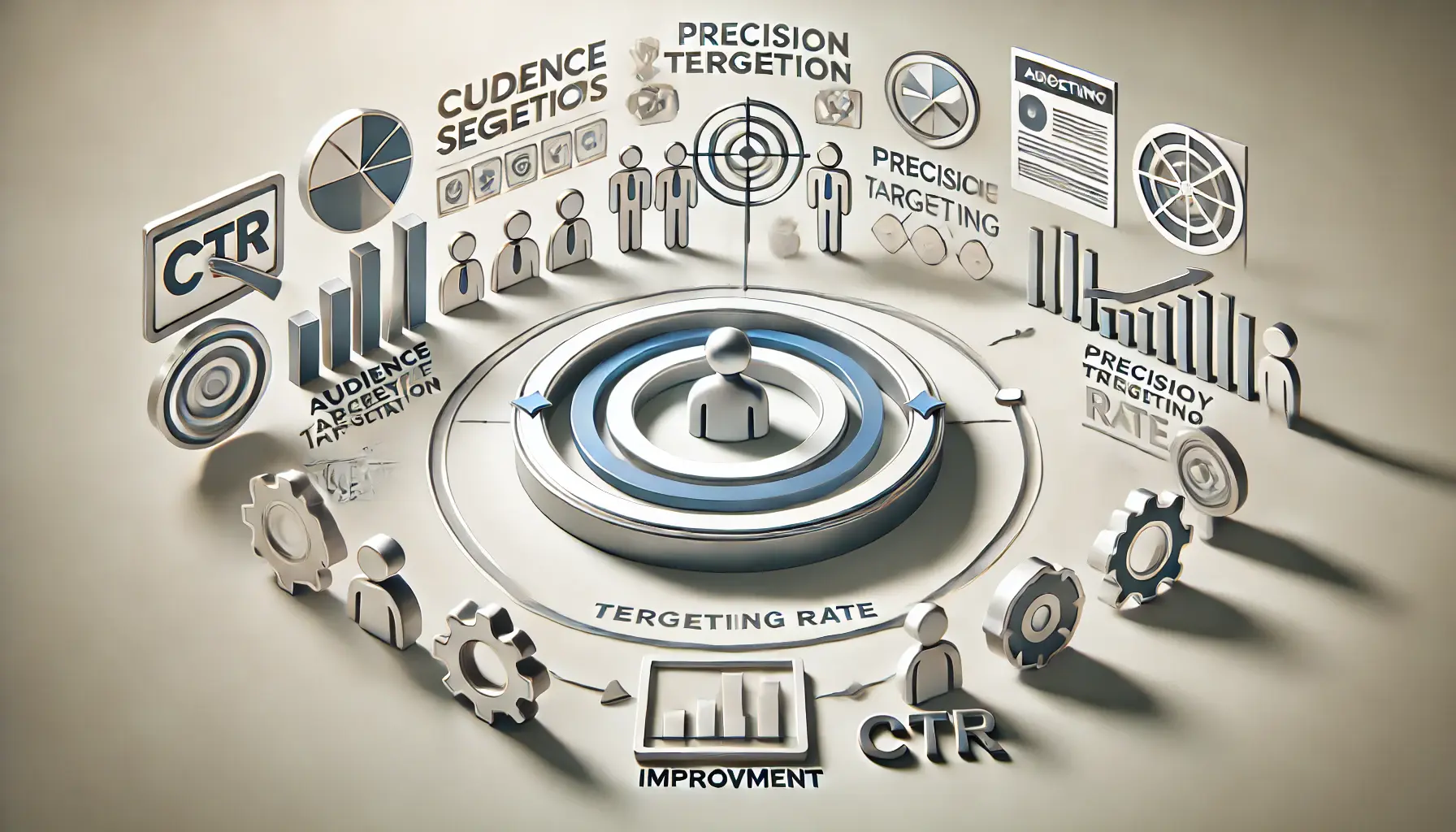
Illustration of customized audience segmentation strategies for targeted CTR improvement.
Customization of Audience Segments for Precise CTR Improvement
Custom audience segments enable you to create highly tailored audiences based on specific behaviors, search history, or interactions.
Customizing segments allows for more precise targeting, which can improve CTR:
- Custom Affinity Audiences: Target users based on specific interests and habits. For instance, if you’re selling hiking gear, you can target users who frequently search for outdoor activities or adventure topics.
- Custom Intent Audiences: Reach users actively researching products or services similar to yours. By targeting users with high purchase intent, you increase the chances of capturing those ready to convert.
- In-Market Audiences: Google’s in-market audience feature allows you to target users currently searching for products or services like yours. These users are often in the buying phase, resulting in higher CTRs.
These audience targeting techniques ensure that Google Ads reach the most relevant and engaged users, boosting CTR and overall ad performance.
By targeting your campaigns according to user demographics, location, and intent, you can optimize ad spend, attract more clicks, and drive meaningful results.
Precise audience targeting boosts CTR by ensuring ads are shown to the most relevant users, increasing engagement and conversions.
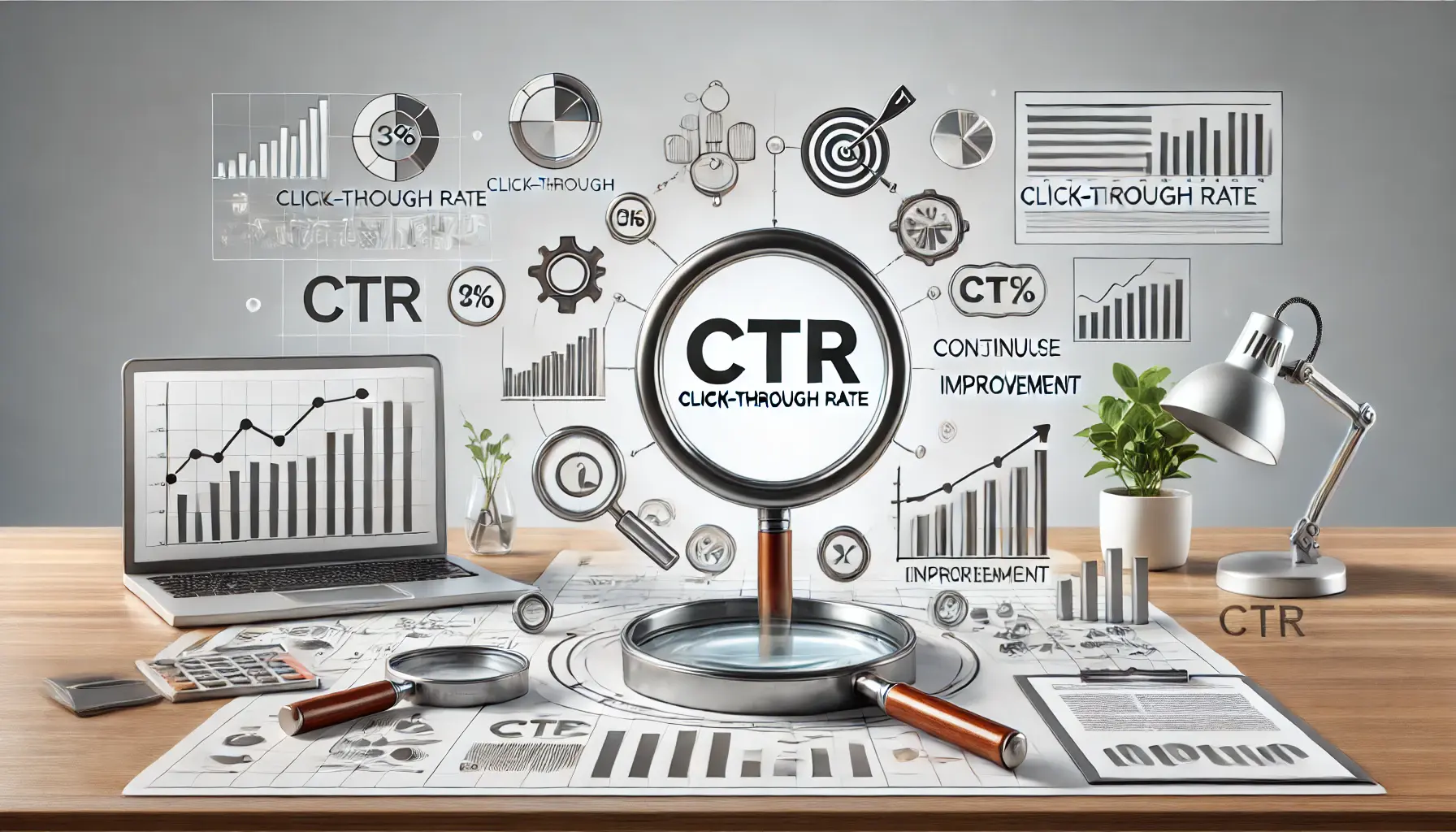
Illustration of continuous CTR monitoring and analysis strategies.
Analyzing and Monitoring CTR for Continuous Improvement
Continuous analysis and monitoring of CTR data are essential for click-through rate improvement in Google Ads.
By consistently assessing what works and what doesn’t, you can refine your strategy toward better ad performance over time.
Monitoring CTR not only indicates the success of your campaigns but also provides insights into audience behavior and engagement patterns, which guide further improvements.
Here’s how you can effectively analyze and monitor CTR for ongoing success.
Illustration of the setup process for efficient CTR tracking in digital advertising.
How to Set Up Efficient CTR Tracking
Accurate tracking is necessary for calculating CTR and other key performance indicators.
Here are some efficient ways to set up CTR tracking in Google Ads:
- Utilize Google Ads Conversion Tracking: Google’s conversion tracking tool provides valuable data on clicks, impressions, and conversions, helping you see how CTR contributes to conversions and ROI.
- Integrate Google Analytics: Connecting Google Ads to Google Analytics enables in-depth data analysis. You can gain insights into user actions on your website after clicking on your ads, allowing you to identify which ads yield the best engagement.
- Monitor Mobile vs. Desktop Performance: CTR can vary between devices. By monitoring CTR across device types, you can identify whether certain ads perform better on mobile or desktop, allowing for device-specific optimizations.
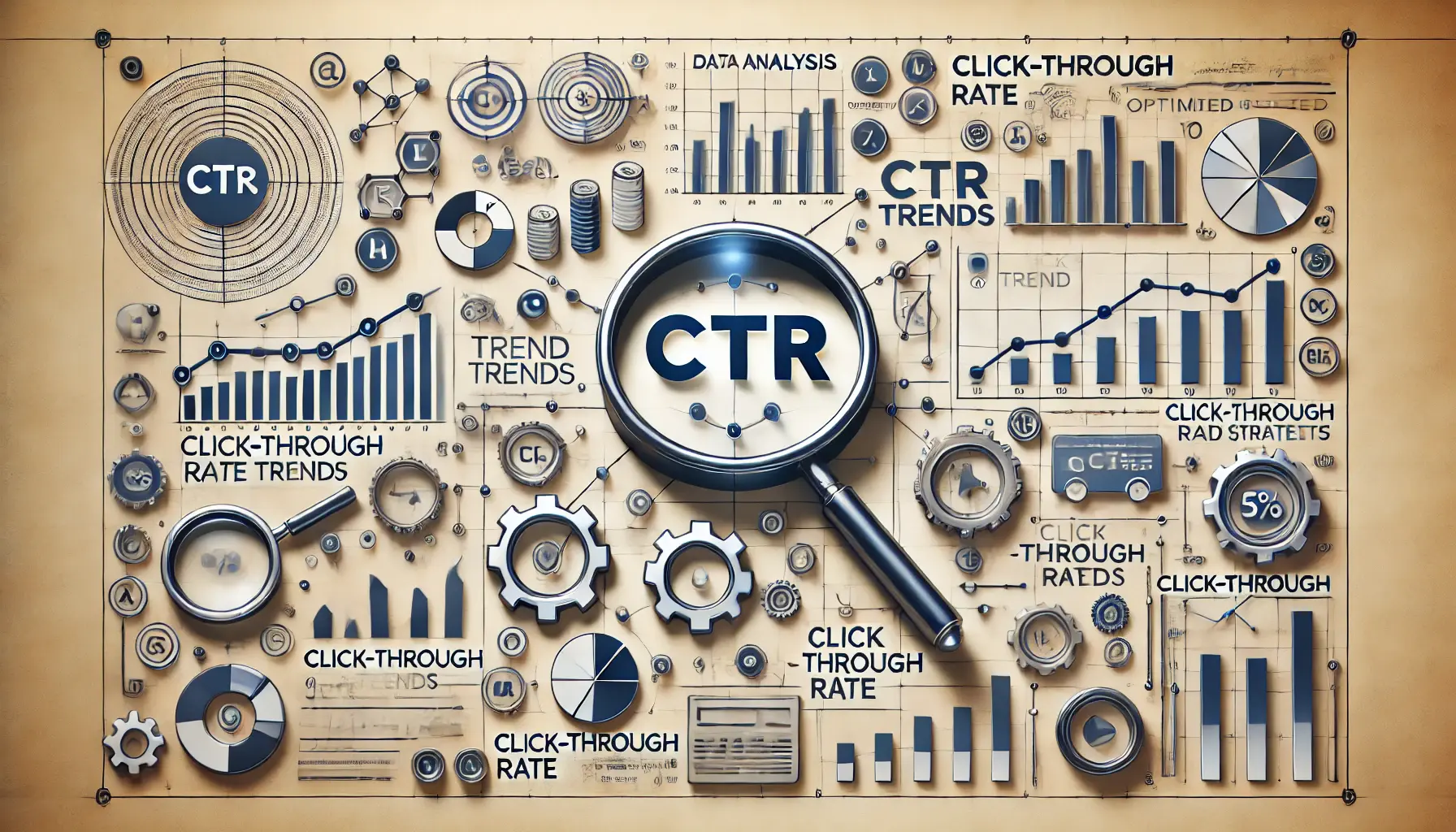
Illustration of methods for analyzing CTR trends and patterns in digital advertising.
Analyzing CTR Trends and Patterns
Regular analysis of CTR trends and patterns helps you understand audience behavior and identify improvement areas.
Focus on the following aspects:
- Seasonal and Time-Based Trends: CTR often fluctuates based on season, day of the week, or even hour of the day. Scheduling ads to align with peak engagement times can maximize CTR.
- Determine High-Performing Ads: Observe which ads consistently yield higher CTRs and analyze elements like ad copy, visuals, or keywords to understand what resonates with your audience.
- CTR Comparison Across Campaigns: Analyze CTR across various campaigns to see which types perform best. For instance, branded campaigns may offer higher CTRs than generic ones, helping inform future campaign structuring.

Illustration of bid adjustment strategies based on Click-Through Rate performance.
Adjusting Bids Based on CTR Performance
Optimizing bids based on CTR performance is an effective way to allocate your budget toward high-performing ads.
Here’s how to adjust bids strategically:
- Raise Bids on High-CTR Keywords: Allocating more budget to high-CTR keywords increases ad visibility, maximizing the value of your ad spend.
- Lower Bids for Low-Performing Keywords: Reducing bids for low-CTR keywords allows you to reallocate budget to better-performing ads, enhancing overall campaign efficiency.
- Leverage Bid Adjustments: Use device, location, and time-based bid adjustments to optimize performance based on identified CTR patterns, improving targeting and CTR.

Illustration of integrating Google Analytics with CTR analysis for enhanced ad insights.
Using Google Analytics to Complement CTR Analysis
Google Analytics provides data beyond CTR, offering a comprehensive view of ad performance and user engagement.
Here’s how to leverage it effectively:
- Analyze On-Site Behavior: Google Analytics enables tracking of user behavior after they click on your ad. Metrics like bounce rate, pages per session, and session duration indicate if your ads are reaching the right audience.
- Measure Conversion Paths: Google Analytics allows you to analyze conversion paths, showing how CTR impacts user journeys toward conversion, which informs further optimizations.
- Segment by Audience Type: Use audience segmentation in Google Analytics to compare CTR and other metrics across different groups, like new vs. returning users, and refine targeting strategies.
Building a habit of analyzing and monitoring CTR data can drive continuous improvement in your Google Ads campaigns.
By applying these strategies, you’ll be making informed adjustments that maximize engagement, ensuring your ads consistently reach and resonate with your target audience.
Continuous CTR analysis helps refine campaign strategies, improving long-term performance and ROI in Google Ads.
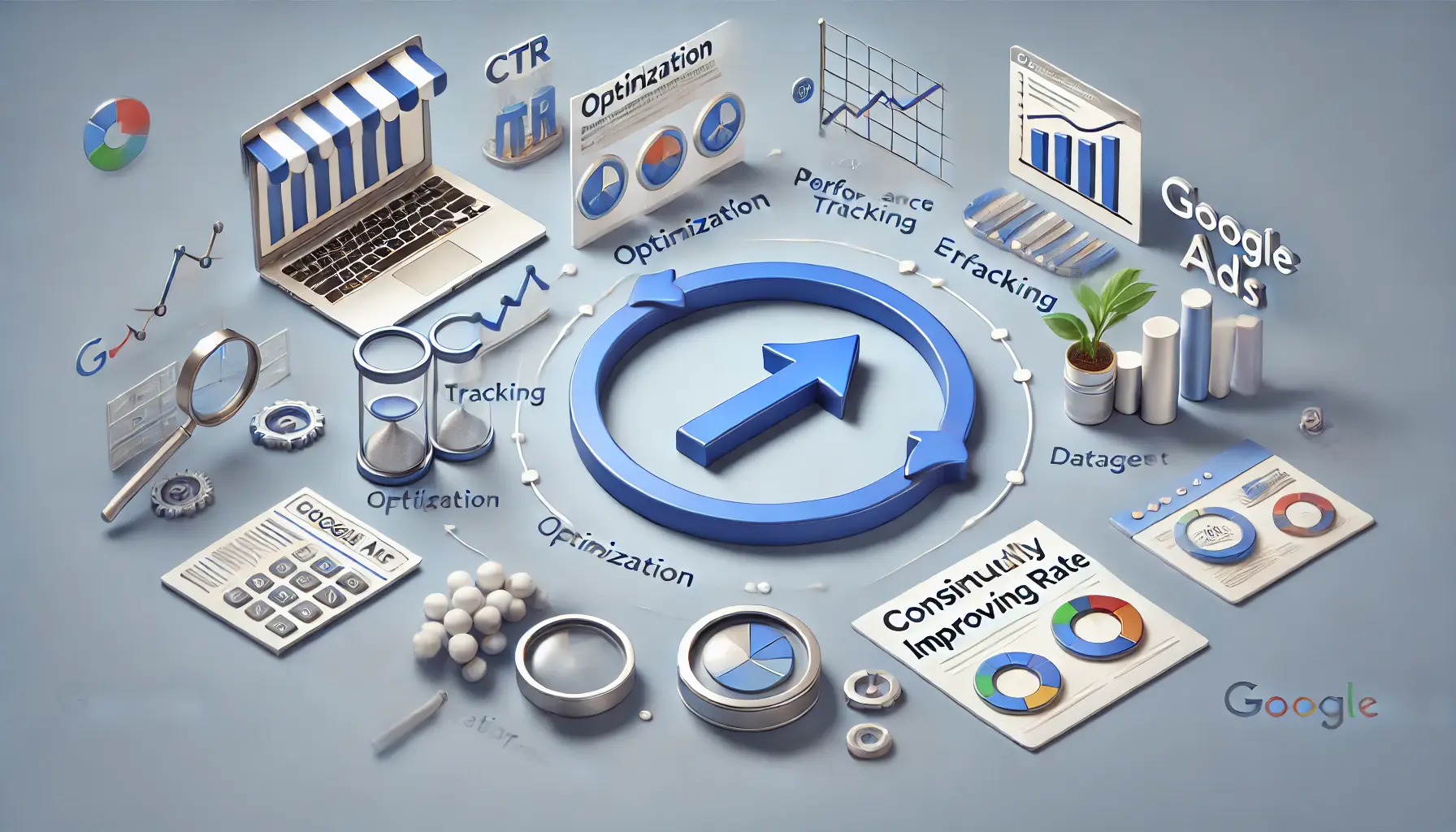
Illustration of methods for consistently enhancing CTR in Google Ads.
How to Always Improve Click-Through Rate in Google Ads
Improving your click-through rate (CTR) in Google Ads is more than just enhancing a metric – it’s a means to boost engagement, reduce costs, and increase conversions.
Through targeted strategies in ad copy, audience targeting, ad formats, and regular monitoring, you can lead your campaigns toward sustained CTR growth.
Let’s summarize the main points and provide a roadmap for future steps in CTR improvement.
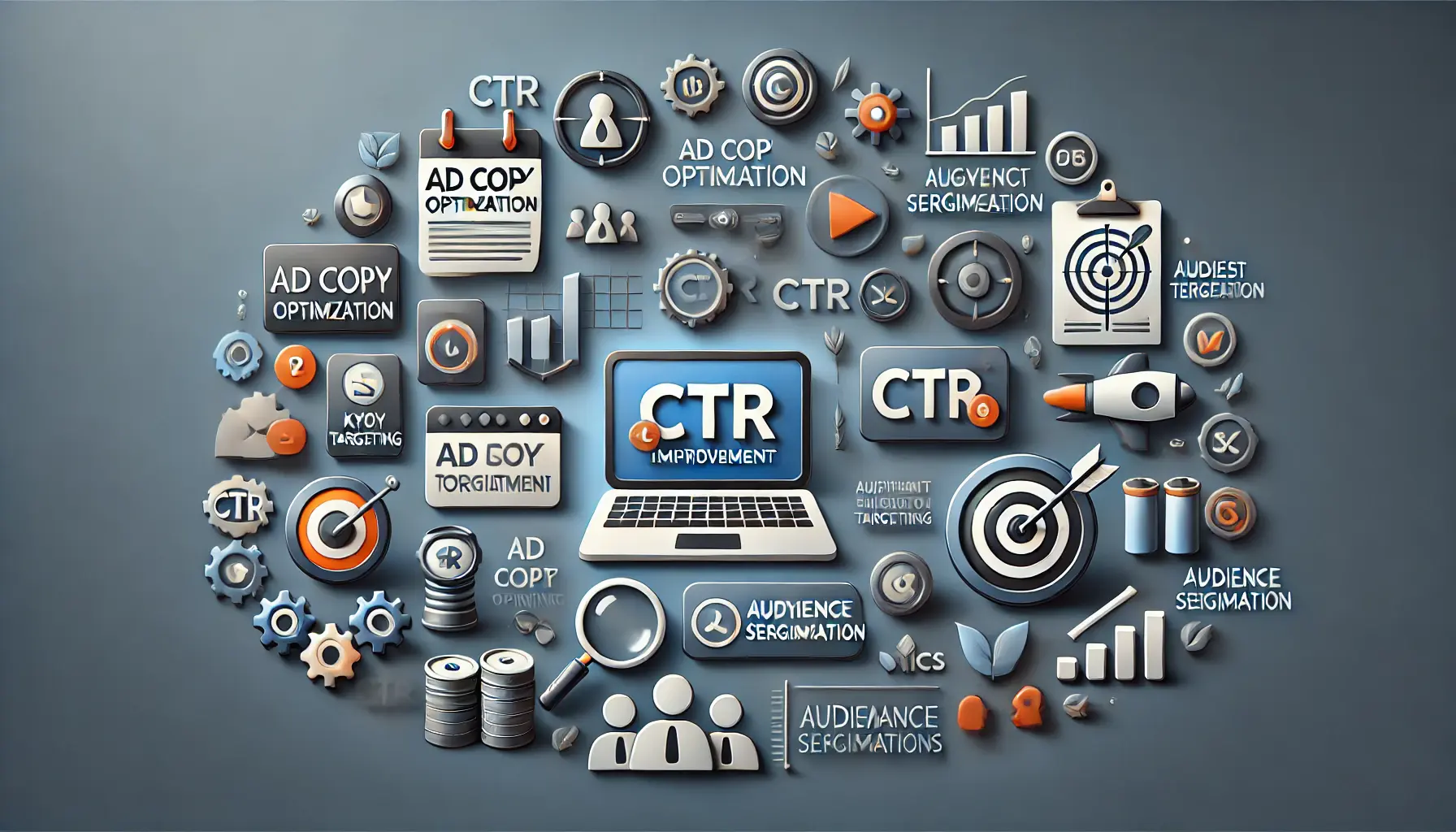
Illustration of foundational strategies for effective CTR improvement.
Key Elements for Effective CTR Improvement
Each of these elements plays a crucial role in setting up a Google Ads campaign for enhanced CTR.
Here’s a quick summary of the essential strategies:
- Craft Compelling Ad Copy: Develop ad copy that speaks to your audience’s needs and concerns. Focus on unique selling points, action-oriented language, and relevant keywords to increase engagement and relevance.
- Apply Appropriate Ad Formats and Visuals: Choosing the right format – from responsive display ads to video content – ensures that your ad aligns with audience preferences. Incorporate high-quality images, consistent branding, and clear CTAs to make your ad stand out.
- Precise Audience Targeting: Effective targeting in terms of demographics, location, and interests helps ensure your ads reach those most likely to engage. Remarketing and custom audiences add further precision.
- Monitor and Adjust Based on Data: Regularly studying CTR trends allows for data-driven decisions. Adjust bids, track mobile vs. desktop performance, and consider seasonal patterns to refine your campaigns.
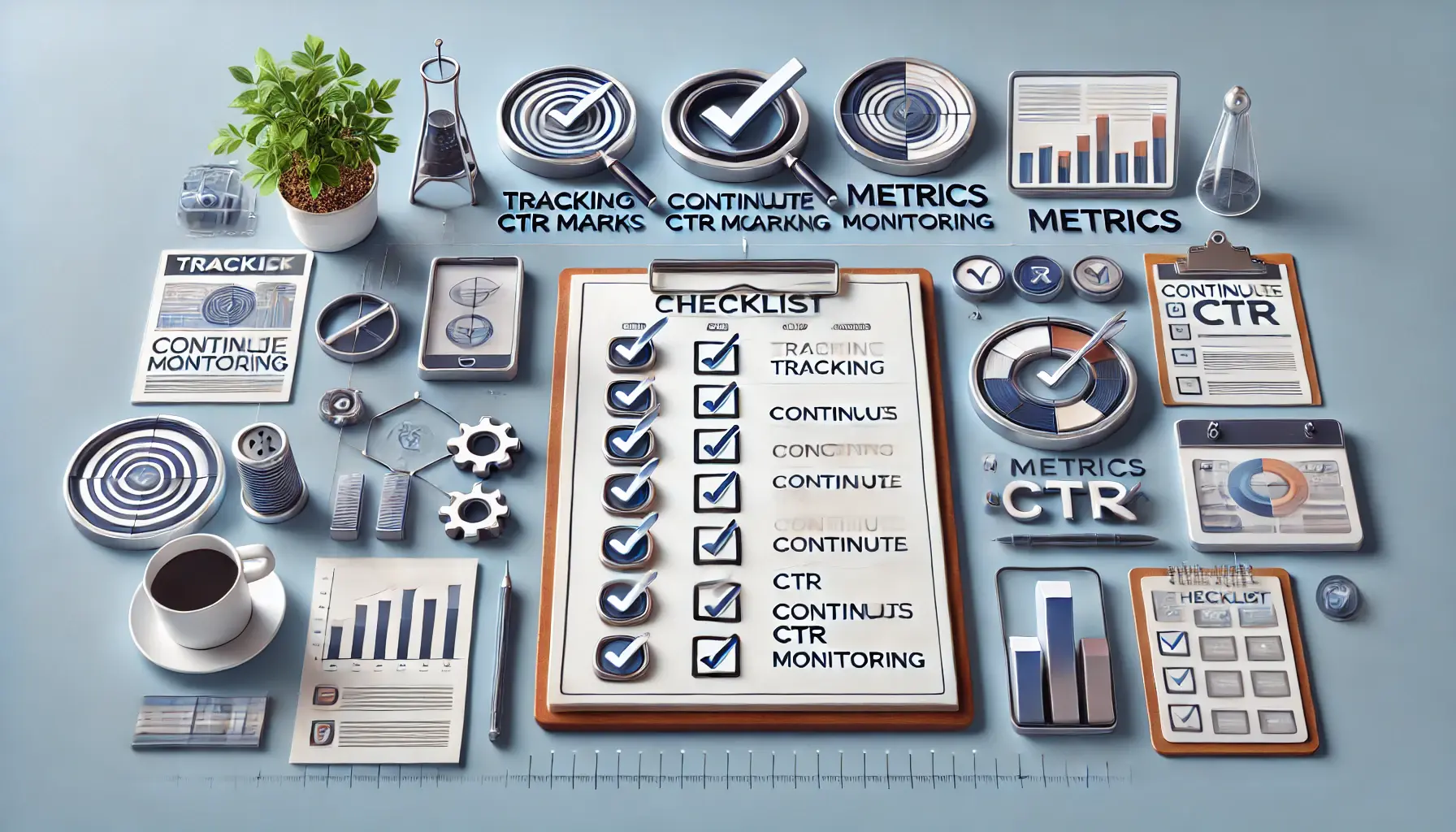
Illustration of a checklist approach for ongoing CTR monitoring.
Checklist for Continuous CTR Monitoring
CTR improvement is an ongoing process.
Consistent monitoring and strategic adjustments are key to maintaining relevance and performance.
Here’s a simple checklist to guide your continuous monitoring efforts:
- Set Up Reliable Tracking: Implement conversion tracking and integrate Google Analytics to gather comprehensive data on CTR, conversions, and user behavior.
- Track Performance Regularly: Schedule periodic reviews of ad performance to identify which strategies yield the best CTR results and make adjustments to underperforming elements as needed.
- Optimize Bids Based on Performance: Use performance data to adjust bids strategically, increasing investment in high-performing keywords while refining budget allocations to drive greater efficiency.
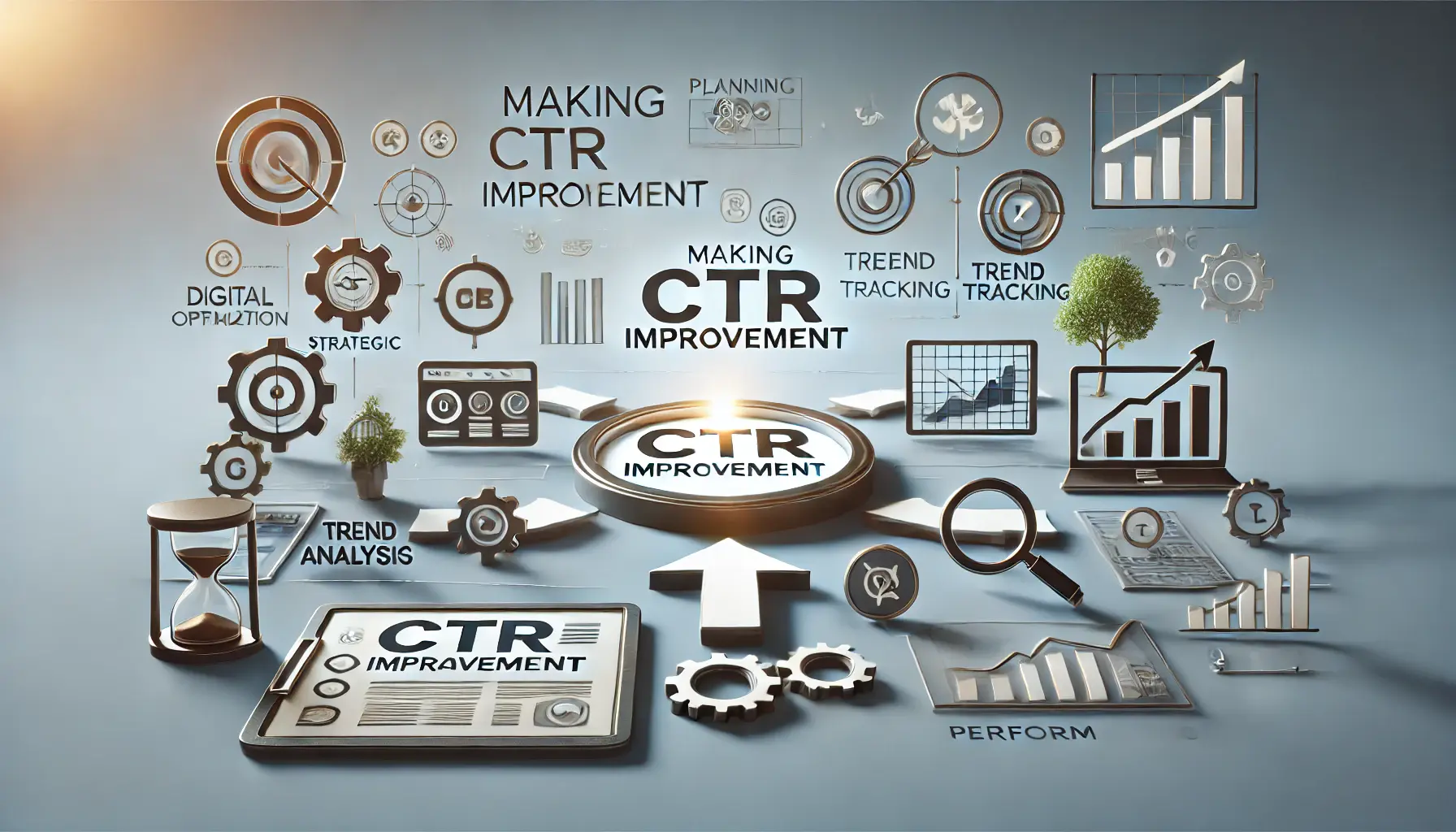
Illustration of integrating CTR improvement into a long-term digital advertising strategy.
Making CTR Improvement Part of Your Long-Term Strategy
Improving CTR in Google Ads isn’t a one-time task; it’s a crucial part of a sustainable and effective ad strategy.
With constant refinement, your ads remain aligned with shifts in audience preferences and industry trends.
Incorporating a long-term strategy centered on CTR improvement can yield maximum returns and enhance your brand’s competitiveness in the market.
Integrate these strategies into your Google Ads campaign, and you’ll be well on your way to continuous click-through rate improvement.
With each step, you not only boost engagement but also ensure your campaigns resonate with the right audience, driving greater success in digital marketing.
Maintaining a focus on CTR improvement ensures sustained ad relevance, better positioning, and reduced costs over time.
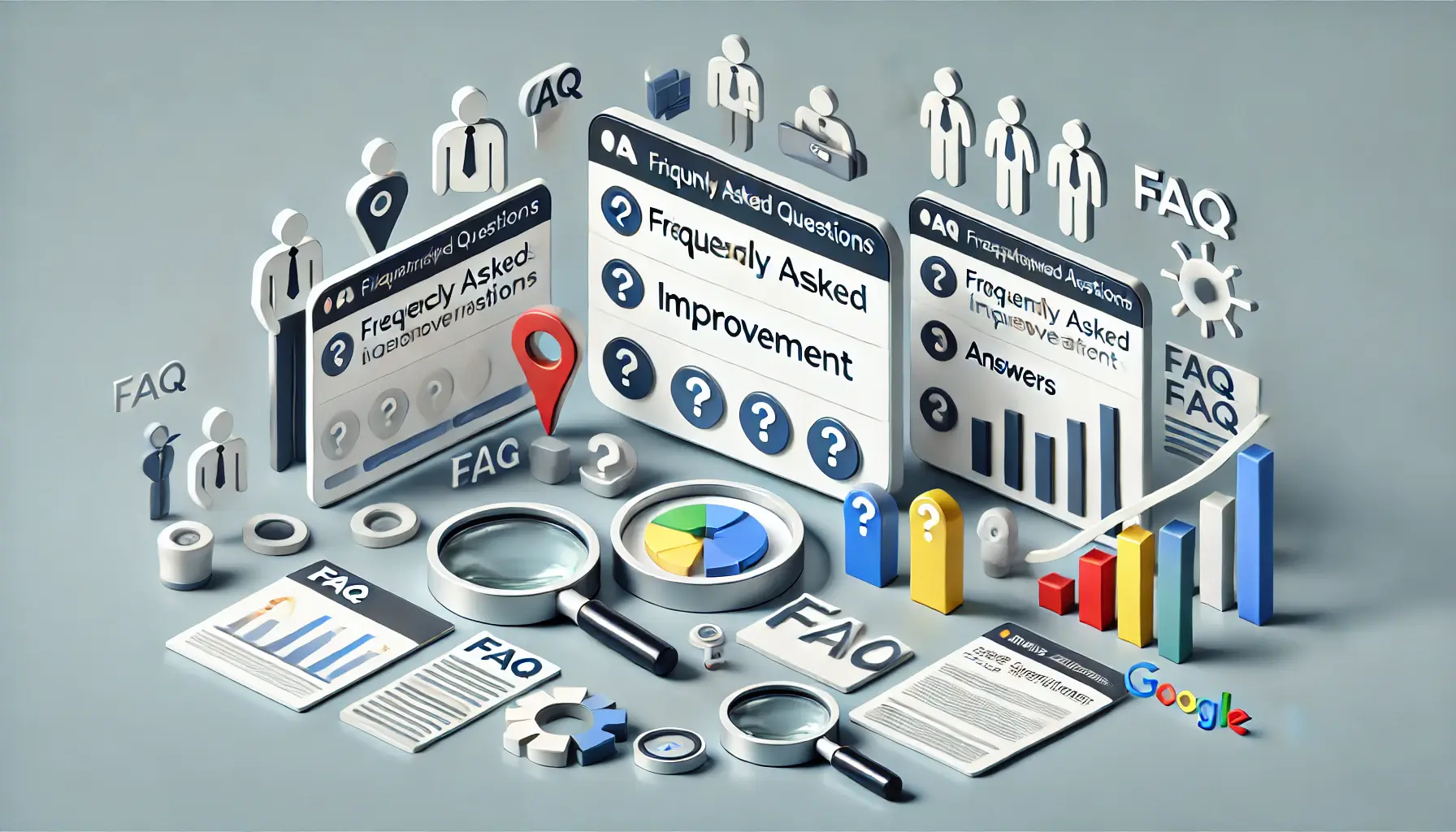
Illustration of a structured FAQ section on CTR improvement in Google Ads.
Your campaigns can be managed by an agency specialized in Google Ads, check out our service page.
Frequently Asked Questions About CTR Improvement in Google Ads
Here are a few of the most frequently asked questions with answers on ways to improve click-through rate (CTR) in Google Ads.
These responses provide a better understanding of strategies, techniques, and best practices for successful ad campaigns.
What qualifies as a good CTR in Google Ads varies by industry.
Typically, a CTR above 2% is considered good, but actual rates depend on factors like ad relevance, target audience, and effective keyword usage.
To optimize CTR, focus on writing compelling ad copy, using targeted keywords, choosing appropriate ad formats, and leveraging audience targeting.
Continuously monitor performance data to make informed adjustments based on observed CTR trends.
CTR is important because it signals ad relevance and audience engagement.
A high CTR generally translates into a good Quality Score, a key factor in determining ad selection and cost-per-click, maximizing campaign effectiveness.
Effective audience targeting ensures ads reach users most likely to engage, increasing CTR.
Targeting specific demographics, interests, and locations helps improve ad relevance and connect with a highly engaged audience.
Choosing the right ad format makes ads more engaging for the audience.
Video ads, responsive display ads, and shopping ads often capture attention effectively, leading to better CTR and enhancing overall campaign performance.
Effectively track CTR in Google Ads by using Google Ads conversion tracking and integrating Google Analytics.
This setup provides comprehensive tracking of CTR, conversions, and on-site behavior for data-driven optimization.
A higher CTR indicates better ad relevance, but it’s not the only performance measure.
Combine CTR data with metrics like conversions and cost-per-click for a comprehensive evaluation of overall ad effectiveness.
Bid adjustments enable strategic budget allocation based on CTR performance.
Increasing bids for high-CTR keywords can improve ad visibility, while lowering bids for low-CTR keywords optimizes overall budget efficiency.
Review CTR data regularly, ideally weekly.
Monitoring trends, adjusting bids, and modifying ad elements as needed ensures high CTR and maintains the effectiveness of campaigns over time.
